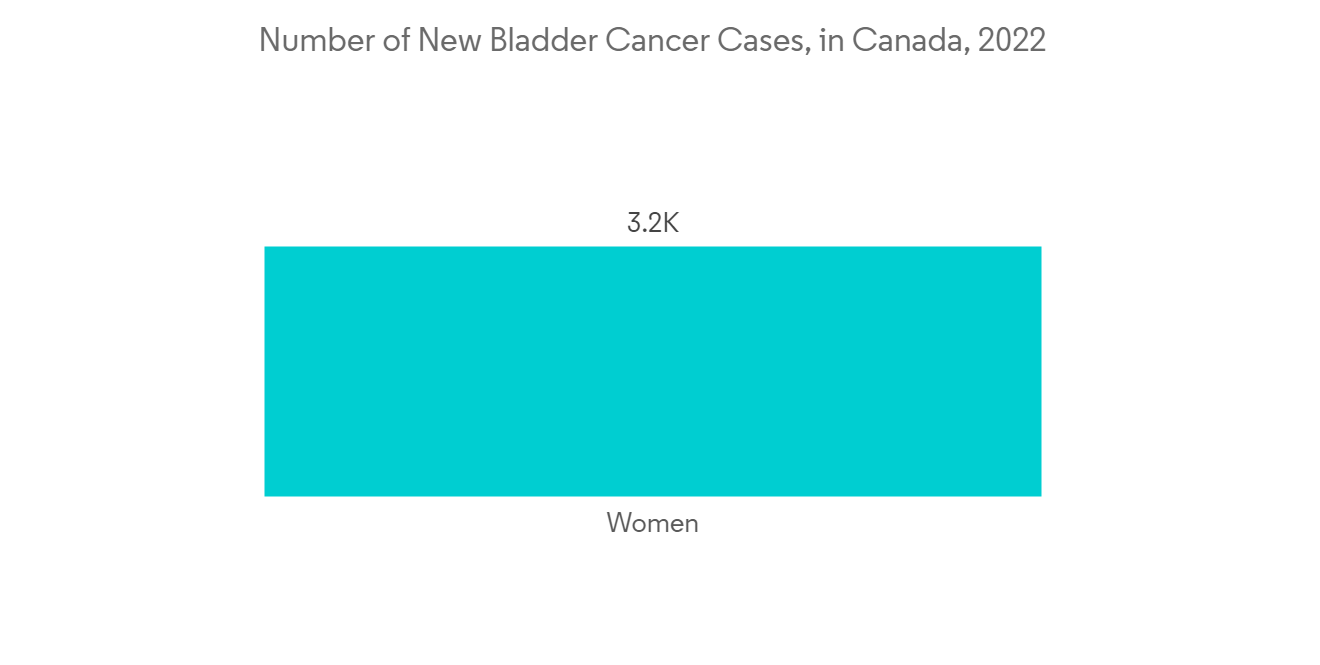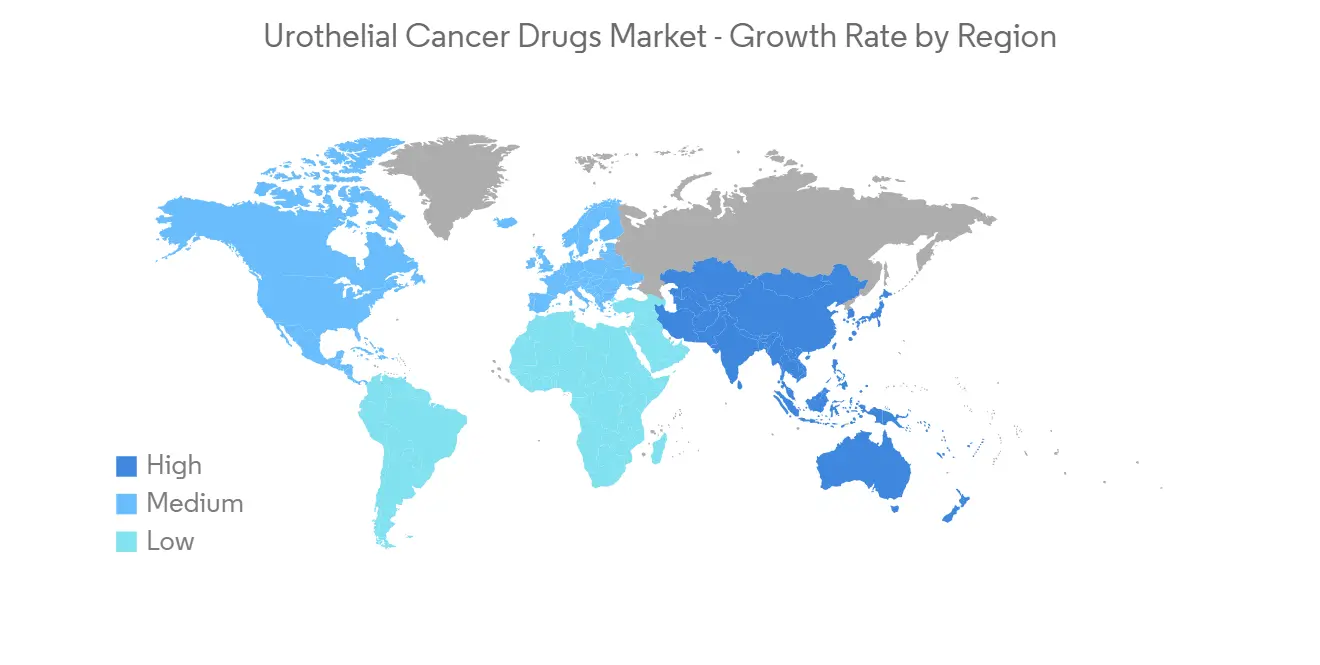PUBLISHER: Mordor Intelligence | PRODUCT CODE: 1273545

PUBLISHER: Mordor Intelligence | PRODUCT CODE: 1273545
Urothelial Cancer Drugs Market - Growth, Trends, and Forecasts (2023 - 2028)
The urothelial cancer drugs market studied is projected to register a CAGR of 15.5% over the forecast period.
The emergence of COVID-19 had a profound impact on the urothelial cancer drugs market. For instance, according to a study published in June 2022, titled "The Impact of the COVID-19 Pandemic on Bladder Cancer Care in the Netherlands," the number of bladder cancer (BC) diagnoses fell by 14% during the first COVID-19 wave but rose back to pre-COVID-19 levels by the end of 2020 (600 diagnoses a month). Treatment-related alterations were kept to a minimum and adhered to the revised guidelines. Additionally, as per the May 2022 updates from the American Urological Association, during the peak of the COVID-19 pandemic in 2020, more than a quarter of patients with bladder cancer experienced care delays in the United States. As a result of the pandemic, the urothelial cancer drug market and also diagnostics had been significantly impacted. However, due to the increasing number of cancer cases, there will be continuing demand for urothelial cancer drugs.
The urothelial cancer drug market may witness rapid growth also due to the increasing awareness about bladder diseases and available therapies, healthcare expenditure, and the growing burden of bladder cancer. For instance, in March 2022, the 'Don't Go Red' theme for Bladder Cancer Awareness has been declared by the World Bladder Cancer Patient Coalition to raise awareness of warning signs and symptoms, as early detection is critical for enhancing long-term survival and quality of life.
Additionally, the increasing prevalence of bladder cancer across the world supports the market expansion over the forest period. For instance, according to the American Cancer Society, in January 2023, it was estimated that about 82,300 cases of bladder cancer would be reported in the United States, of which 62,400 will be men and 19,900 will be women. Thereby, a high number of bladder cancer cases is going to elevate the need for urothelial cancer drugs. However, side effects associated with drugs are likely to impede market growth.
Urothelial Cancer Drugs Market Trends
The Chemotherapy Segment is Expected to Witness the Fastest Growth Over the Forecast Period
Chemotherapy drugs may be used alone or in combination, depending on the purpose of their usage. Chemotherapy is the most common form of therapeutics used to stop or slow down the growth of urothelial cancer cells. It works throughout the whole body to destroy and keep cancer cells spreading to other parts of the body away from the original tumor. As chemotherapy is considered a first-line treatment for the treatment of urothelial cancer, the segment is expected to see a surge over the forecast period. The rise in the adoption of chemotherapy, the rising prevalence of bladder cancer, and product launches by the key market players drive the segment.
According to the National Cancer Institute, in 2022, a combination of two chemotherapy drugs, gemcitabine, and docetaxel, was given to patients with bladder cancer, and around 82% of individuals who received periodic treatment with both drugs after surgery to remove their bladder tumor were still alive two years later without their cancer returning.

North America is Expected to Dominate the Urothelial Cancer Drugs Market
North America is expected to dominate the market owing to factors such as a high number of cancer cases and new drug approvals in the region are among the key factors contributing to the growth of the studied market in North America. For instance, in 2022, the FDA approved the first gene therapy for the treatment of high-risk, non-muscle-invasive bladder cancer. This drug approval provides healthcare professionals with innovative treatment options. Such new treatment developments are going to elevate the market growth.
Factors such as the high number of bladder cancer cases within the region are going to elevate the need for urothelial cancer drugs. For instance, according to the American Cancer Society, in 2023, the estimated number of new bladder cancer cases is about 82,290 within the United States.
Moreover, the Canadian Cancer Society estimated that, in 2022, around 13,300 Canadians were diagnosed with bladder cancer, and about 2,500 Canadians were to die from bladder cancer. There is a high need for urothelial cancer drugs to treat cancer patients, which is elevating market growth.

Urothelial Cancer Drugs Industry Overview
The urothelial cancer drug market is consolidated in nature due to the presence of a few companies operating globally as well as regionally. The competitive landscape includes an analysis of a few international and local companies that hold market shares and are well known, including Merck & Co. Inc., F Hoffmann-La Roche AG, Bristol-Myers Squibb Company, AstraZeneca PLC, and Novartis AG, among others.
Additional Benefits:
- The market estimate (ME) sheet in Excel format
- 3 months of analyst support
TABLE OF CONTENTS
1 INTRODUCTION
- 1.1 Study Assumptions and Market Definition
- 1.2 Scope of the Study
2 RESEARCH METHODOLOGY
3 EXECUTIVE SUMMARY
4 MARKET DYNAMICS
- 4.1 Market Overview
- 4.2 Market Drivers
- 4.2.1 Emergence and Priority of Targeted Therapy Among Biopharmaceutical Companies
- 4.2.2 Growing Burden of Urothelial Cancer
- 4.2.3 Increasing Awareness on Bladder Diseases and Available Therapies
- 4.3 Market Restraints
- 4.3.1 Side Effects Associated with Drugs
- 4.4 Industry Attractiveness - Porter's Five Forces Analysis
- 4.4.1 Bargaining Power of Buyers/Consumers
- 4.4.2 Bargaining Power of Suppliers
- 4.4.3 Threat of New Entrants
- 4.4.4 Threat of Substitute Products
- 4.4.5 Intensity of Competitive Rivalry
5 MARKET SEGMENTATION (Market Size by Value - USD Million)
- 5.1 By Treatment
- 5.1.1 Chemotherapy
- 5.1.2 Immunotherapy
- 5.2 Geography
- 5.2.1 North America
- 5.2.1.1 United States
- 5.2.1.2 Canada
- 5.2.1.3 Mexico
- 5.2.2 Europe
- 5.2.2.1 Germany
- 5.2.2.2 United Kingdom
- 5.2.2.3 France
- 5.2.2.4 Italy
- 5.2.2.5 Spain
- 5.2.2.6 Rest of Europe
- 5.2.3 Asia-Pacific
- 5.2.3.1 China
- 5.2.3.2 Japan
- 5.2.3.3 India
- 5.2.3.4 Australia
- 5.2.3.5 South Korea
- 5.2.3.6 Rest of Asia-Pacific
- 5.2.4 Middle East and Africa
- 5.2.4.1 GCC
- 5.2.4.2 South Africa
- 5.2.4.3 Rest of Middle East and Africa
- 5.2.5 South America
- 5.2.5.1 Brazil
- 5.2.5.2 Argentina
- 5.2.5.3 Rest of South America
- 5.2.1 North America
6 COMPETITIVE LANDSCAPE
- 6.1 Company Profiles
- 6.1.1 Merck & Co. Inc.
- 6.1.2 F Hoffmann-La Roche AG
- 6.1.3 Bristol-Myers Squibb Company
- 6.1.4 AstraZeneca PLC
- 6.1.5 Novartis AG
- 6.1.6 GlaxoSmithKline PLC
- 6.1.7 Sanofi SA
- 6.1.8 Eisai Co. Ltd.
- 6.1.9 Astellas Pharma
- 6.1.10 UroGen Pharma
- 6.1.11 Pfizer Inc.
- 6.1.12 Genentech USA Inc.
7 MARKET OPPORTUNITIES AND FUTURE TRENDS




